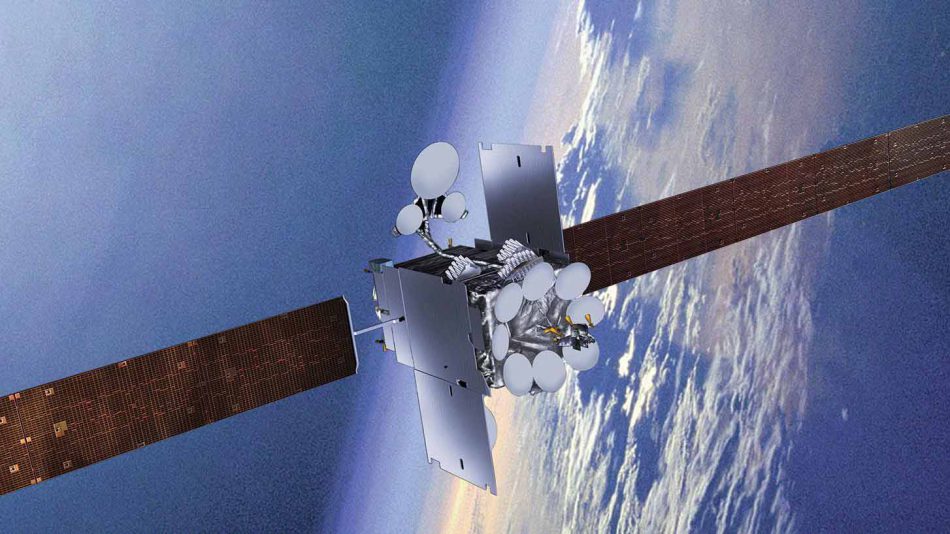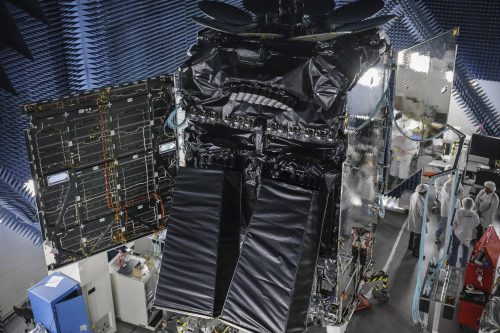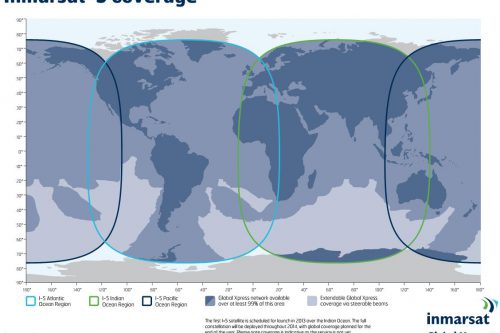
Back to selection
GEO Satellite
Inmarsat-5 F4 (Inmarsat GX4) (In-orbit Spare) GEO
succesfull
Launch date
15 May 2017
Dedicated Mission
Country

Purpose
Communication
Position
6° East (In-orbit Spare)
Manufacturer
Operator
Launch operator
Launch vehicle
Falcon 9
Expected lifetime
15+ Years

Region
Europe Region
Inmarsat-5 F4 satellite is operated by satellite operator Inmarsat from the UK. The satellite is the fourth of the next-generation Inmarsat fleet satellites aimed to boost connectivity speeds for users on-the-move in airplanes, on boats and on land. Inmarsat-5 F4 was ordered in 2013 to act as an early spare and give the constellation a flexible member that can be used to respond to growing demands for broadband connectivity.
The launch contract for Inmarsat 5-F4 was awarded to launch operator SpaceX. Initially, the satellite was expected to launch atop a Falcon Heavy rocket, given its mass exceeds the payload capability for Falcon 9 launch with core stage recovery.
However, with Falcon Heavy’s debut repeatedly slipping, a contract clause was exercised to switch the satellite from Falcon Heavy to a fully expendable Falcon 9 to keep a first half 2017 launch date. The launch of Inmarsat’s, EuropaSat spacecraft was therefor moved from SpaceX to Ariane 5 as the result of the continued delays with Falcon Heavy.
With 89 fixed and steerable Ka-band beams, the Global Xpress satellites represent new territory for Inmarsat, which used a different radio band on earlier satellites. Switching from L-band to Ka-band improves downlink communications speeds to 50Mbps, with up to 5Mbps on the uplink side. And users can link up with the Global Xpress satellites with smaller terminals. Inmarsat-5 F1 will take up operations at 63° East longitude covering the Indian Ocean region.
In August 2010 satellite operator Inmarsat ordered three Ka-band Inmarsat-5 satellites from Boeing to deliver faster broadband to its commercial and government customers by end-2014. In October 2013, Inmarsat ordered a fourth satellite as a spare, i.e. Inmarsat-5 F4.
The fixed-price contract with options, valued at 1 billion USD, calls for three high-powered BSS-702HP commercial spacecraft that will operate in geosynchronous orbit with flexible global coverage.
Each Inmarsat-5 satellite will carry 89 Ka-band beams that will operate in geosynchronous orbit with flexible global coverage. The satellites are designed to generate approximately 15kW of power at the start of service and approximately 13.8kW at the end of their 15-year design life. To generate such high power, each spacecraft’s two solar wings employ five panels each of ultra-triple junction gallium arsenide solar cells. The BSS-702HP carries the xenon ion propulsion system (XIPS) for all on-orbit maneuvering. When operational, the Inmarsat-5 satellites will provide Inmarsat with a comprehensive range of global mobile satellite services, including mobile broadband communications for deep-sea vessels, in-flight connectivity for airline passengers and streaming high-resolution video, voice and data.
The Boeing satellites will provide Inmarsat with the ability to adapt to shifting subscriber usage patterns of high data rates, specialized applications and evolving demographics over a projected 15-year lifetime. In a separate arrangement, Boeing has also entered into a distribution partnership with Inmarsat to provide L- and Ka-band capacity to key users within the U.S. government.
The Inmarsat-5 spacecraft are compatible with the Arianespace’ Ariane 5, Sea Launch Zenit-3SL, ILS’ Proton and ULA’sAtlas launch vehicles. Launch services were procured by Inmarsat.
Intelsat-5 F4 was successfully launched on May 15th, 2017, on a Falcon 9 rocket booster, operated by launch operator SpaceX, from Launch Pad 39A at Kennedy Space Center at Cape Canaveral in Florida, USA.
GEO Satellite
Inmarsat-5 F4 (Inmarsat GX4) (In-orbit Spare)
succesfull
GEO Satellite
Inmarsat-5 F4 (Inmarsat GX4) (In-orbit Spare)
succesfull





